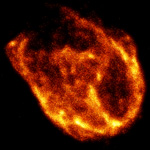September 10, 1999
CXC PR: 99-04
The High Resolution Camera (HRC), one of the two X-ray cameras on NASA's Chandra X-ray Observatory, was placed into the focus for the first time on Monday, August 30. The first target was LMC X-1, a point-like source of X rays in the Large Magellanic Cloud. The Large Magellanic Cloud, a companion galaxy to the Milky Way, is 160,000 light years from Earth. After checking the focus with LMC X-1, Chandra observed N132D, a remnant of an exploded star in the Large Magellanic Cloud.
"These were preliminary test observations," emphasized Dr. Stephen Murray, of the Harvard-Smithsonian Center for Astrophysics, principal investigator for the High Resolution Camera. "But we are very pleased with the results. All indications are that the HRC will produce X-ray images of unprecedented clarity."
The N132D image shows a highly structured remnant, or shell, of 10-million-degree gas that is 80 light years across. Such a shell in the vicinity of the Sun would encompass more than fifty nearby stars. The amount of material in the N132D hot gas remnant is equal to that of 600 suns.
The N132D supernova remnant appears to be colliding with a giant molecular cloud, which produces the brightening on the southern rim of the remnant. The molecular cloud, visible with a radio telescope, has the mass of 300,000 suns. The relatively weak x-radiation on the upper left shows that the shock wave is expanding into a less dense region on the edge of the molecular cloud. A number of small circular structures are visible in the central regions and a hint of a large circular loop can be seen in the upper part of the remnant. Whether the peculiar shape of the supernova remnant can be fully explained in terms of these effects, or whether they point to a peculiar cylindrically shaped explosion remains to be seen.
-more-
"The image is so rich in structure that it will take a while to sort out what is really going on," Murray said. "It could be multiple supernovas, or absorbing clouds in the vicinity of the supernova."
The unique capabilities of the HRC stem from the close match of its imaging capability to the focusing power of the mirrors. When used with the Chandra mirrors, the HRC will make images that reveal detail as small as one-half an arc second. This is equivalent to the ability to read a stop sign at a distance of twelve miles. The checkout period for the HRC will continue for the next few weeks, during which time the team expects to acquire images of other supernova remnants, star clusters, and starburst galaxies.
To follow Chandra's progress, visit the Chandra News Web site at:
NASA's Marshall Space Flight Center in Huntsville, Alabama, manages the Chandra X-ray Observatory for NASA's Office of Space Science, NASA Headquarters, Washington, D.C. The Smithsonian Astrophysical Observatory's Chandra X-ray Center in Cambridge, Mass., manages the Chandra science program and controls the observatory for NASA. TRW Space and Electronics Group of Redondo Beach, Calif., leads the contractor team that built Chandra.
High resolution digital versions of the X-ray image (300 dpi JPG, TIFF) and other information associated with this release are available on the Internet at:
NASA TV on the web
MEDIA CONTACTS
Dr. Wallace Tucker
Chandra X-ray Observatory Center
Smithsonian Astrophysical Observatory, Cambridge, MA
Phone: 617-496-7998
Dave Drachlis
Marshall Space Flight Center, Huntsville, AL
Phone: 256-544-0034



